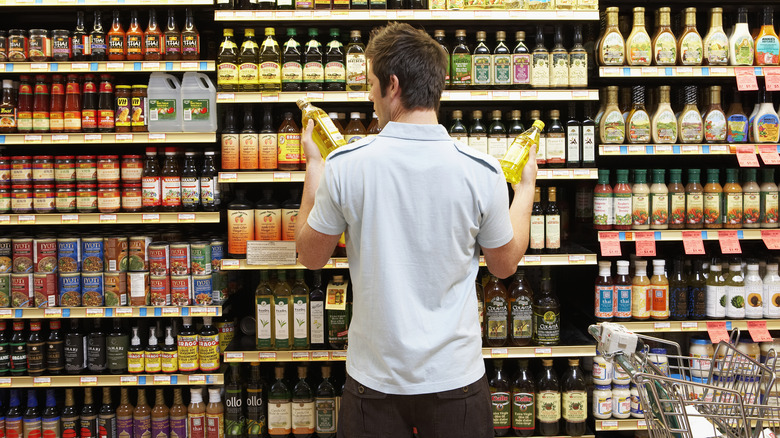The Tricky Reason Grocery Store Aisles Are So Long
Grocery shopping is a task that divides opinion: You either really love it or you really don't. But like doing laundry and filing taxes, it's a necessity. When it comes to stocking up on household essentials, saving money is a top priority for many shoppers. Many resort to clipping coupons and opting for Buy One, Get One (BOGO) deals to reduce the final cost at the checkout register. Bringing a shopping list is another effective strategy to cut back on unnecessary spending, as is the time-honored advice of never shopping on an empty stomach.
However, despite your best efforts to stay within budget, you might still find yourself buying more than you intended. It turns out that those lengthy trips down grocery aisles might be the culprit.
Many retailers deliberately design their aisles to be long, with rows of items stacked high, for a reason: They want you to spend more time scanning the shelves to find what you need. With so many eye-catching and delectable items along the way, you might end up snagging a few unplanned products to add to your cart, much to the presumed delight of the grocery store.
Grocery stores are designed to make you spend more
Longer shopping aisles aren't the only tactic retailers use to encourage more spending. From placing more expensive products at eye level to positioning popular items in the middle of the aisle, the store's layout is cleverly designed for the same reason. But that's not all: Grocery stores also rearrange their layout to subtly influence your spending. If you've ever visited your local market to find it completely reorganized, you've already encountered this sneaky strategy.
Like the lengthy shelves, some retailers switch around their aisles and the locations of various products, so you spend more time searching for what you need. The end goal, of course, is for you to discover — and hopefully purchase — new items in the process. Although most stores typically rearrange their layout annually, don't be surprised if some choose to change aisles around every six months or so.
Other tricks grocery stores use to maximize profits
If you're grocery shopping on a budget, you may want to opt for a basket, considering the strategies some grocery store chains use to entice you to spend more. For instance, some provide customers with exceptionally large shopping carts, hoping the ample storage space will encourage people to buy more items.
Many stores also practice "charm pricing," which involves pricing items so the price ends in $0.99, $0.95, and similar figures. Since people read from left to right, they often prioritize a product price's leftmost digit, a phenomenon known as "left-digit bias." For example, an item priced at $9.99 might be perceived by some as $9, even though it's actually much closer to $10.
In much the same way that essentials like eggs, butter, and dairy are placed at the back of the store — so you have to walk through all those long aisles to reach them — grocery stores are also very particular about what they stock at the front. Although perishable items like meat and dairy should be the last groceries you grab on every trip, don't be surprised if you find yourself adding bags of chips, candies, and other snack items to your cart at the checkout. The register and its vicinity is where stores often keep small, inexpensive items fully stocked, in the hope that you'll grab them at the last minute.



